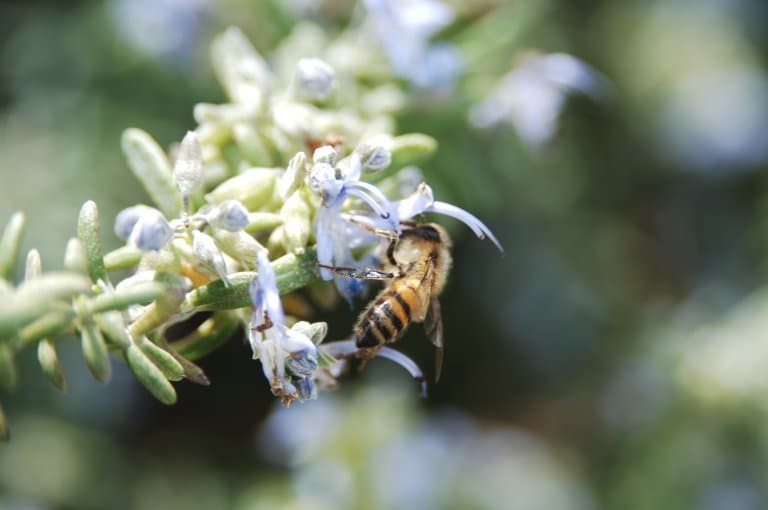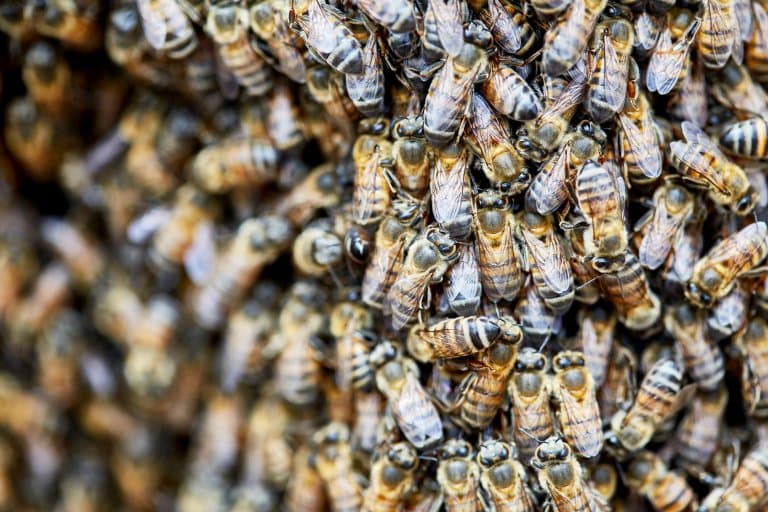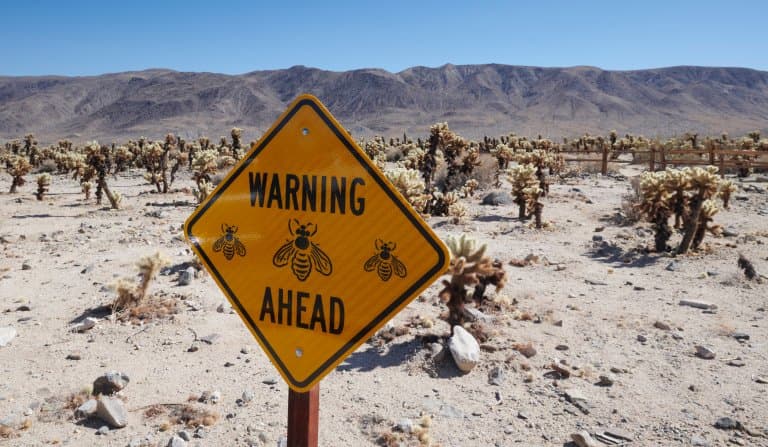Africanized Bee Profile
We’ve talked about the irrational fear of wasps, and how they are unfairly represented as relentless killing machines who will chase and slaughter you at any chance they get.
Meanwhile, bees get off the hook because they generally keep to themselves, and besides, we like their honey and how they pollinate our food crops and flowers. Well, nobody’s ever heard of a killer wasp.
Africanized “killer” bees are a tropical hybrid between the European honeybee and the East African Lowland honeybee; both are the same species, but have totally different approaches to life.

Africanized Bee Facts Overview
| Habitat: | Tropical |
| Location: | South America up to Southern North America |
| Lifespan: | Queens live for around 5 years |
| Size: | Around 10mm |
| Weight: | <1g |
| Color: | Dark brown, sometimes golden brown |
| Diet: | Nectar, pollen |
| Predators: | Birds, reptiles, humans |
| Top Speed: | Up to 25 kph (15 mph) |
| No. of Species: |
1 |
| Conservation Status: |
Not Listed |
The hybrid Africanised bee brings with it in its genes, a substantial portion of the African bee philosophy: Both a wild and competitive nature that reflects its harsh and difficult ecosystem; but also, a freedom to move and choose where to live throughout the year.
But these bees also bring with them some serious African bee attitude. They are hyper-aggressive compared with their European cousins, quick to anger, and will chase for 2-4 times as far when they’re mad.
This has led to deaths, as it often does on their home continent. And this scares people who have become accustomed to the placid, docile nature of the European bee.
Interesting Africanized Bee Facts
1. They were supposed to help!
Organically, this hybrid would never have happened. The two subspecies are separated by thousands of miles of ocean, and would never meet under normal circumstances.
But the lowland bee from Africa was introduced on purpose, due to its eagerness and high productivity in tropical environments, to be bred with the European subspecies in the area to create a more productive colony.
While the European honeybee did well in the temperate areas of North America, they aren’t well suited to tropical climates, which is why they’re easily overtaken by the African subspecies.
Queen bees can be inseminated with a 50/50 mix of European and African sperm, and they’ll still use as much as 90% of the sperm from the African deposit. Nobody knows why, but this is a huge factor in their invasiveness across the continent.
Further, the queens sired by African drones emerge from their cells a day sooner, giving them ample time to kill off their competition. On top of this, the African subspecies will invade a colony, kill the resident queen and install their own.
This makes them one of the most successful invaders known.
Of course, some escaped, and rampaged through South America, out-competing and inter-breeding with their counterparts, who, as you might be able to tell from the name, were not native there either.
However, they’re not actually as good as livestock as European bees. 1

2. They are fussier
African bees are not as eager to please in several ways. One of the most significant of these, to a person who wants to keep them at home, is that they are quite prone to leaving if conditions aren’t perfect.
This might be a hive that’s too big, a hive that’s too small, one that’s too high or too low, or they just don’t like the smell of your aftershave. They’ll also disappear if you disturb them too much; something that comes with the territory of traditional beekeeping inspections.
All of this means that holding onto a colony can be an issue. But even if you manage to make one especially happy, they still might not pull their weight.
European bees store honey for winter. They plan to bunker down and raid the larder until it’s warm enough to go our foraging again. Tropical subspecies don’t have that mindset, and when it gets cold, they’re more likely to go looking for a better place to live. 2
3. They swarm frequently
In their home territories, there’s food all year round. This means, as long as it’s not raining too much, they can forage whenever they need to.
As such, they have no qualms about swarming regularly and often, and when they do this, they’ll take half the workforce and a bunch of their honey with them.
Swarming can be managed with regular inspections, but (see above) they don’t like that much either.
4. They make smaller, faster colonies
Even a productive and loyal colony is generally smaller than a European honeybee colony and will store less honey too. Again, they’re not programmed to think about the Winter, so their stores aren’t typically as large.
Instead, they’ll make enough to get them through rainy days, when the tropical storms make flying dangerous.
All this adds up to a bee that won’t stay put, doesn’t make much honey, and will attack you if you look at it funny. Plus, they’re expanding 300 miles a year up the landmass. But there are some upsides. 3
5. They’re not more painful
Despite their fearsome reputation, a sting from an Africanized honeybee isn’t more painful or more potent. It’s still unpleasant, of course, but the potency of the venom itself isn’t what makes them dangerous.
These bees kill people because they can chase for up to half a kilometre, and have a significantly lower tolerance to threats than other subspecies.
This means they’ll attack in greater numbers and for longer, and if you’re unlucky enough to be on the receiving end, there’s a much higher chance of receiving a lethal dose of the venom.
And this isn’t just a threat to beekeepers or honey thieves, it causes significant damage to livestock and wild animals too. Still, in most cases, they won’t swarm anything unless they are directly affected.
They are estimated to have killed 1,000 humans, with many of the victims receiving 10 times more stings than from European honey bees.

6. They might be calming down a bit
As the media-invoked terror surrounding the progressive march toward the US took off, researchers were relieved to notice that the invaders from South America appeared to be getting less aggressive.
Nobody’s sure exactly why, but it might have something to do with the subspecies they’re inter-breeding with.
There’s also an element of society involved. Bee colonies often appear to have distinct personalities, even when the subspecies are the same, and as social animals, they do have some degree of culture. The behaviour of one bee affects the others, and aggression can be passed on this way.
As bees head North, they may be encountering calmer cultures and unlearn some of the aggressive behaviours that came with them.
Other barriers to their progress include cold winters and evenly-distributed rainfall. While they’re perfectly capable of riding out a tropical rainy season, rainfall throughout the year stifles them and they don’t like it. 4
7. They’re still just bees
Africanized honeybees are no worse or more dangerous than African honeybees, which are kept by apiculturists all over the continent. They simply demand more care and a wider birth than the European bees. 5
Just like wasps, bees just want to be left alone and aren’t out to get people. Issues arise when people and stinging insects decide to call the same location home, and one must defend their family from the other.
Still, with a bit of respect and a slight shift in expectations towards bees, there’s little reason for anyone to die from them, killer or otherwise. 6
8. They kill on average 2-3 people a year
The Africanized honey bee is still widely feared by the public, and this has been amplified by myth and media!
Stings from these ‘killer bees’ kill on average 2-3 people a year, which is far less than say domesticated dogs.

Africanized Bee Fact-File Summary
Scientific Classification
| Kingdom: | Animalia |
| Phylum: | Arthropoda |
| Class: | Insecta |
| Order: | Hymenoptera |
| Family: | Apidae |
| Tribe: | Apini |
| Genus: | Apis |
| Species: | Apis Mellifera |
Fact Sources & References
- Emily Osterloff, “Killer bees: a deadly swarm”, Natural History Museum.
- “Africanised honey bee”, Bee Aware.
- Stephen E. Doyle (2013), “Africanized killer bees: facts and tips”, Ehrlich.
- W.S. Robinson (2018), “Killer bees are calming down”, High Country News.
- Chrissy Sexton (2020), “Killer bees are aggressive by nurture, not just by nature”, Earth.
- “Africanized Honey Bees”, University of Georgia.
